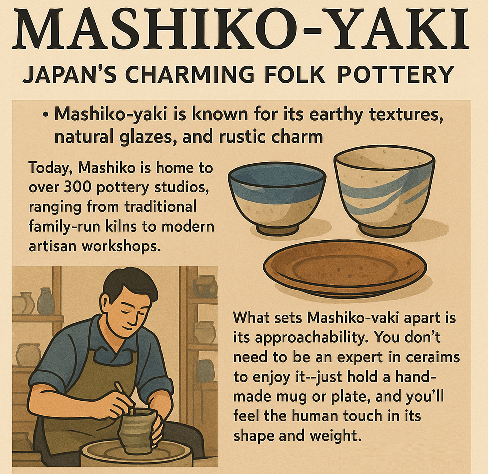
If you’re a fan of traditional Japanese crafts, a visit to Mashiko in Tochigi Prefecture should be on your itinerary. This quiet town, just a few hours north of Tokyo, is famous for Mashiko-yaki, a style of pottery that reflects the warmth and simplicity of rural Japan.
Unlike some of Japan’s more refined ceramics, Mashiko-yaki is known for its earthy textures, natural glazes, and rustic charm. Originally developed in the late Edo period (19th century), it was made primarily for everyday use—rice bowls, teacups, storage jars. But in the 20th century, Mashiko’s reputation skyrocketed thanks to Shoji Hamada, a key figure in the Mingei (folk craft) movement. His philosophy: beauty lies in utility.
Today, Mashiko is home to over 300 pottery studios, ranging from traditional family-run kilns to modern artisan workshops. Visitors can stroll through the town’s peaceful streets, browse local galleries, and even take part in hands-on pottery workshops to create their own Mashiko piece.
What sets Mashiko-yaki apart is its approachability. You don’t need to be an expert in ceramics to enjoy it—just hold a handmade mug or plate, and you’ll feel the human touch in its shape and weight.
Whether you’re a collector, a curious traveler, or someone who simply loves handmade goods, Mashiko-yaki offers a tangible connection to Japanese culture that you can literally hold in your hands.
益子焼を発見する:日本の魅力的な民芸陶器
もしあなたが伝統的な日本の工芸のファンならば、栃木県の益子町を旅程に加えるべきです。この静かな町は、東京から数時間北に行ったところにあり、益子焼という、田舎の日本の温かさと素朴さを映し出す陶器のスタイルで有名です。
日本のより洗練された陶磁器とは異なり、益子焼は、その土っぽい質感、自然な釉薬、そして素朴な魅力で知られています。この焼き物は江戸時代後期(19世紀)に主に日常使いのために作られ始めました――ご飯茶碗、湯飲み、保存用の壺などです。しかし20世紀に入ると、益子の評判は、民芸運動の重要人物である濱田庄司によって一気に高まりました。彼の哲学は「美は実用性の中にある」でした。
今日、益子には300を超える陶芸工房があります。それは伝統的な家族経営の窯元から、現代的な職人の工房までさまざまです。訪問者は町の静かな通りを歩き、地元のギャラリーを見て回り、自分自身の益子焼作品を作る体験型の陶芸ワークショップに参加することもできます。
益子焼を際立たせているのは、その親しみやすさです。陶芸の専門家である必要はありません――手作りのマグカップやお皿を手に取れば、その形や重みに職人の手のぬくもりを感じることができます。
あなたが収集家であろうと、好奇心旺盛な旅行者であろうと、または単に手作りの品を愛する人であろうと、益子焼は、文字通り手に取ることのできる、日本文化との実感的なつながりを提供してくれるのです。
